英语修辞 手法
英语最全修辞手法

英语常用修辞1.Simile 明喻明喻是将具有共性的不同事物作对比。
这种共性存在于人们的心里,而不是事物的自然属性。
或者说是以两种具有相同特征的事物和现象进行对比,表明本体和喻体之间的相似关系,两者都在对比中出现。
标志词常用like,as, seem, as if, as though, similar to,such as等。
It is a figure of speech which makes a comparison between two unlike elements having at least one quality or characteristic in common。
To make the comparison,words like as, as.。
as,as if and like are used to transfer the quality we associate with one to the other.例如:1〉.He was like a cock who thought the sun had risen to hear him crow。
2〉.I wandered lonely as c cloud.3〉。
Einstein only had a blanket on,as if he had just walked out of a fairy tale.4>。
This elephant is like a snake as anybody can see.这头象和任何人见到的一样像一条蛇。
5〉.He looked as if he had just stepped out of my book of fairytales and had passed me like a spirit。
他看上去好像刚从我的童话故事书中走出来,像幽灵一样从我身旁走过去。
英语18种重要修辞手法
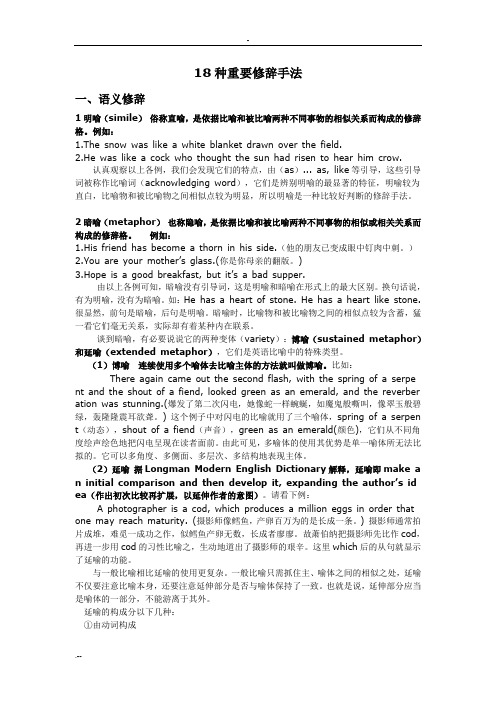
18种重要修辞手法一、语义修辞1明喻(simile)俗称直喻,是依据比喻和被比喻两种不同事物的相似关系而构成的修辞格。
例如:1.The snow was like a white blanket drawn over the field.2.He was like a cock who thought the sun had risen to hear him crow.认真观察以上各例,我们会发现它们的特点,由(as)... as, like等引导,这些引导词被称作比喻词(acknowledging word),它们是辨别明喻的最显著的特征,明喻较为直白,比喻物和被比喻物之间相似点较为明显,所以明喻是一种比较好判断的修辞手法。
2暗喻(metaphor)也称隐喻,是依据比喻和被比喻两种不同事物的相似或相关关系而构成的修辞格。
例如:1.His friend has become a thorn in his side.(他的朋友已变成眼中钉肉中刺。
)2.You are your mother’s glass.(你是你母亲的翻版。
)3.Hope is a good br eakfast, but it’s a bad supper.由以上各例可知,暗喻没有引导词,这是明喻和暗喻在形式上的最大区别。
换句话说,有为明喻,没有为暗喻。
如:He has a heart of stone. He has a heart like stone.很显然,前句是暗喻,后句是明喻。
暗喻时,比喻物和被比喻物之间的相似点较为含蓄,猛一看它们毫无关系,实际却有着某种内在联系。
谈到暗喻,有必要说说它的两种变体(variety):博喻(sustained metaphor)和延喻(extended metaphor),它们是英语比喻中的特殊类型。
(1)博喻连续使用多个喻体去比喻主体的方法就叫做博喻。
比如:There again came out the second flash, with the spring of a serpe nt and the shout of a fiend, looked green as an emerald, and the reverber ation was stunning.(爆发了第二次闪电,她像蛇一样蜿蜒,如魔鬼般嘶叫,像翠玉般碧绿,轰隆隆震耳欲聋。
英语中有19种修辞手法
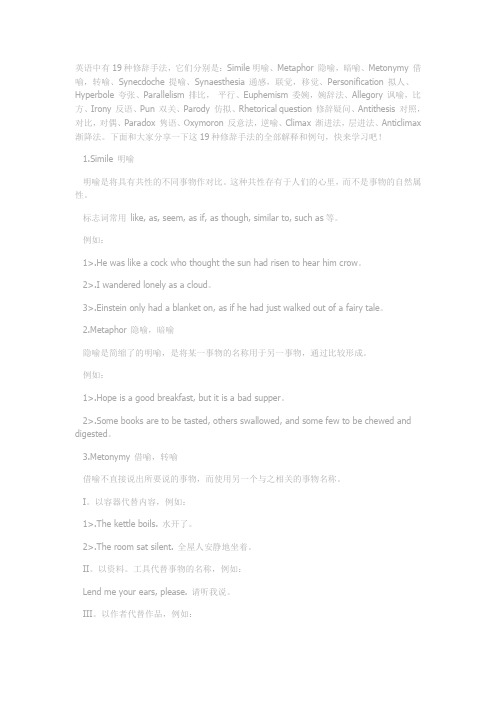
英语中有19种修辞手法,它们分别是:Simile明喻、Metaphor 隐喻,暗喻、Metonymy 借喻,转喻、Synecdoche 提喻、Synaesthesia 通感,联觉,移觉、Personification 拟人、Hyperbole 夸张、Parallelism 排比,平行、Euphemism 委婉,婉辞法、Allegory 讽喻,比方、Irony 反语、Pun 双关、Parody 仿拟、Rhetorical question 修辞疑问、Antithesis 对照,对比,对偶、Paradox 隽语、Oxymoron 反意法,逆喻、Climax 渐进法,层进法、Anticlimax 渐降法。
下面和大家分享一下这19种修辞手法的全部解释和例句,快来学习吧!1.Simile 明喻明喻是将具有共性的不同事物作对比。
这种共性存有于人们的心里,而不是事物的自然属性。
标志词常用like, as, seem, as if, as though, similar to, such as等。
例如:1>.He was like a cock who thought the sun had risen to hear him crow。
2>.I wandered lonely as a cloud。
3>.Einstein only had a blanket on, as if he had just walked out of a fairy tale。
2.Metaphor 隐喻,暗喻隐喻是简缩了的明喻,是将某一事物的名称用于另一事物,通过比较形成。
例如:1>.Hope is a good breakfast, but it is a bad supper。
2>.Some books are to be tasted, others swallowed, and some few to be chewed and digested。
英语中所有19种修辞手法的全部解释和例句
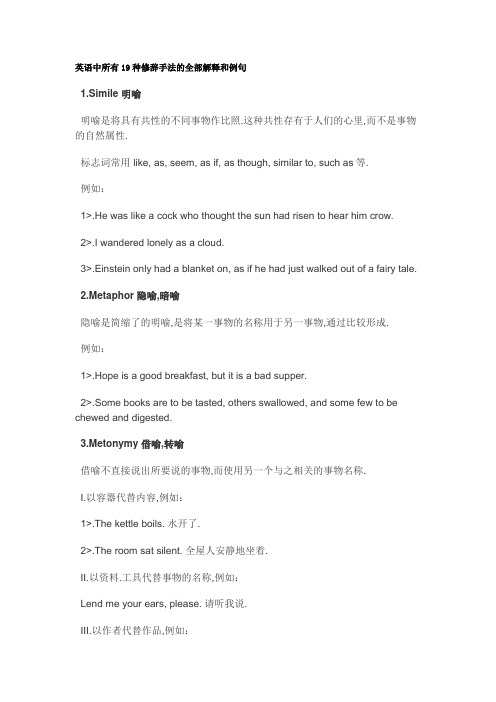
英语中所有19种修辞手法的全部解释和例句1.Simile 明喻明喻是将具有共性的不同事物作比照.这种共性存有于人们的心里,而不是事物的自然属性.标志词常用 like, as, seem, as if, as though, similar to, such as等.例如:1>.He was like a cock who thought the sun had risen to hear him crow.2>.I wandered lonely as a cloud.3>.Einstein only had a blanket on, as if he had just walked out of a fairy tale.2.Metaphor 隐喻,暗喻隐喻是简缩了的明喻,是将某一事物的名称用于另一事物,通过比较形成.例如:1>.Hope is a good breakfast, but it is a bad supper.2>.Some books are to be tasted, others swallowed, and some few to be chewed and digested.3.Metonymy 借喻,转喻借喻不直接说出所要说的事物,而使用另一个与之相关的事物名称.I.以容器代替内容,例如:1>.The kettle boils. 水开了.2>.The room sat silent. 全屋人安静地坐着.II.以资料.工具代替事物的名称,例如:Lend me your ears, please. 请听我说.III.以作者代替作品,例如:a complete Shakespeare 莎士比亚全集VI.以具体事物代替抽象概念,例如:I had the muscle, and they made money out of it. 我有力气,他们就用我的力气赚钱.4.Synecdoche 提喻提喻用局部代替全体,或用全体代替局部,或特殊代替一般.例如:1>.There are about 100 hands working in his factory.(局部代整体)他的厂里约有100名工人.2>.He is the Newton of this century.(特殊代一般)他是本世纪的牛顿.3>.The fox goes very well with your cap.(整体代局部)这狐皮围脖与你的帽子很相配.5.Synaesthesia 通感,联觉,移觉这种修辞法是以视.听.触.嗅.味等感觉直接描写事物.通感就是把不同感官的感觉沟通起来,借联想引起感觉转移,“以感觉写感觉”。
(完整版)英语中的修辞手法

英语中的修辞手法1.明喻(Simile)明喻是一种最简单、最常见的修辞方法,是以两种具有共同特征的事物或现象进行对比,表明本体和喻体的关系,两者都在对比中出现,其基本格式是“A像B”,常用的比喻词有as, like, as if, as though等。
例如:●He jumped back as if he had been stung, and the blood rushedsintoshis wrinkled face.●The cheque fluttered to the floor like a bird with a broken wing. (支票跌落到地上,像一只断了翅膀的小鸟。
)●Like climbing a mountain, we struggle up three feet and fall back two.(正如爬山,我们费力爬上三英尺,又掉下去两英尺。
)I see also the dull, drilled, docile, brutish masses of the Hun soldiery blodding on like a swarm of crawling locusts.(丘吉尔在此使用了一个恰当的比喻,把德国士兵比作蝗虫,因为二者有着共同之处-传播毁灭。
)2.暗喻(Metaphor)暗喻也是一种比喻,但不用比喻词,因此被称作缩减了的明喻(a compressed simile)。
它直接把一种事物名称用在另一事物上,从而更生动、更深刻地说明事理,增强语言的表现力。
例如:●What will parents do without the electronic baby-sitter? (如果没有这位电子保姆,父母该怎么办呢?)形象地说明了电视机的保姆功用。
●... while most of us are only too ready to apply to others the cold wind of criticism, we are somehow reluctant to give our fellows the warm sunshine of praise.(……但是我们中的很多人太容易给别人批评的冷风,而不愿意给自己的同伴赞扬的阳光。
英语修辞手法45种

45种英语修辞(1)alliteration(押头韵):一组单词的第一个辅音相同.When the things happen that you do not like, you have two choices: You get bitter or better(2)metaphor(隐喻):利用某些单词进行含蓄的比喻,此时这些单词已经不再是字面上的意思了,Strawberries flooded the market and prices dropped down. (草莓充斥市场,价格下跌)。
(3)anadiplosis(联珠):将一个或一组单词重复多遍,Men in great place are thrice servants: servants of state, servants of fame, and servants of business.(4)anaphora(首语重复):将一个句子的开头单词或短语,在随后的句子中重复多遍.We shall fight on the seas and oceans, we shall fight on the beaches, we shall fight on the landing grounds, we shall fight in the fields and in the streets, we shall fight in the hills.(5)anastrophe(词序倒装): 改变正常词序,比如例句中最后一部分,正常词序是yet a breeze never blew up 。
The helmsman steered, the ship moved on, yet never a breeze up blew.(6)antistrophe(逆反复):在每个句子的结尾,重复相同的单词或短语,比如例句中的without warning。
英语中修辞手法
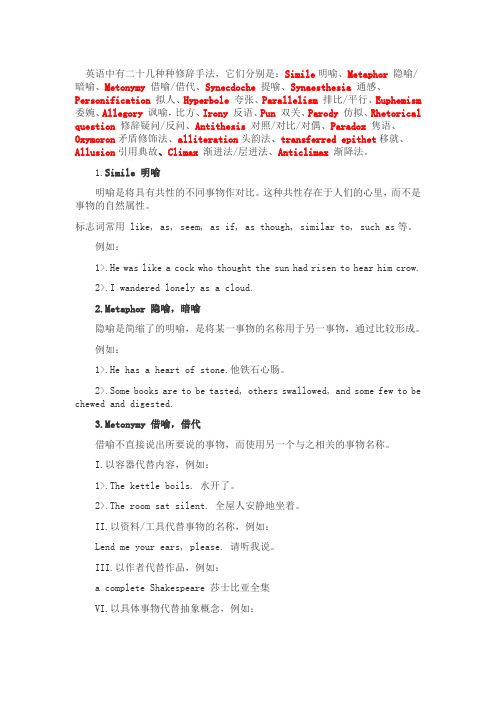
英语中有二十几种种修辞手法,它们分别是:Simile明喻、Metaphor隐喻/暗喻、Metonymy借喻/借代、Synecdoche提喻、Synaesthesia 通感、Personification拟人、Hyperbole夸张、Parallelism排比/平行、Euphemism 委婉、Allegory 讽喻,比方、Irony反语、Pun双关、Parody仿拟、Rhetorical question修辞疑问/反问、Antithesis对照/对比/对偶、Paradox隽语、Oxymoron矛盾修饰法、alliteration头韵法、transferred epithet移就、Allusion引用典故、Climax渐进法/层进法、Anticlimax渐降法。
1.Simile 明喻明喻是将具有共性的不同事物作对比。
这种共性存在于人们的心里,而不是事物的自然属性。
标志词常用 like, as, seem, as if, as though, similar to, such as等。
例如:1>.He was like a cock who thought the sun had risen to hear him crow.2>.I wandered lonely as a cloud.2.Metaphor 隐喻,暗喻隐喻是简缩了的明喻,是将某一事物的名称用于另一事物,通过比较形成。
例如:1>.He has a heart of stone.他铁石心肠。
2>.Some books are to be tasted, others swallowed, and some few to be chewed and digested.3.Metonymy 借喻,借代借喻不直接说出所要说的事物,而使用另一个与之相关的事物名称。
I.以容器代替内容,例如:1>.The kettle boils. 水开了。
20种英语修辞手法整理
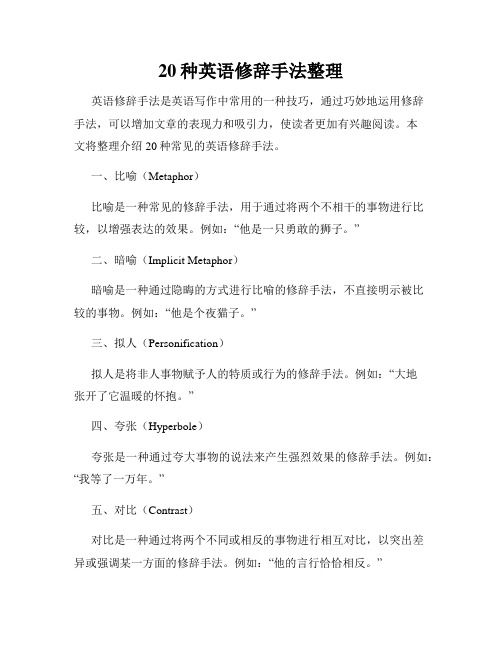
20种英语修辞手法整理英语修辞手法是英语写作中常用的一种技巧,通过巧妙地运用修辞手法,可以增加文章的表现力和吸引力,使读者更加有兴趣阅读。
本文将整理介绍20种常见的英语修辞手法。
一、比喻(Metaphor)比喻是一种常见的修辞手法,用于通过将两个不相干的事物进行比较,以增强表达的效果。
例如:“他是一只勇敢的狮子。
”二、暗喻(Implicit Metaphor)暗喻是一种通过隐晦的方式进行比喻的修辞手法,不直接明示被比较的事物。
例如:“他是个夜猫子。
”三、拟人(Personification)拟人是将非人事物赋予人的特质或行为的修辞手法。
例如:“大地张开了它温暖的怀抱。
”四、夸张(Hyperbole)夸张是一种通过夸大事物的说法来产生强烈效果的修辞手法。
例如:“我等了一万年。
”五、对比(Contrast)对比是一种通过将两个不同或相反的事物进行相互对比,以突出差异或强调某一方面的修辞手法。
例如:“他的言行恰恰相反。
”六、排比(Parallelism)排比是一种通过对句子或短语进行平行结构的修辞手法,以强调重点或增加语句的节奏感。
例如:“奋斗,拼搏,追求,努力。
”七、倒装(Inversion)倒装是一种颠倒语序的修辞手法,常常用于疑问句或为了强调某一部分。
例如:“Never have I seen such a beautiful sunset.”八、反问(Rhetorical Question)反问是一种用疑问句的形式表达肯定或否定的修辞手法,常用于强调某一观点或引起读者思考。
例如:“难道你不想成功吗?”九、比较(Comparison)比较是通过将两个事物进行对比,以凸显共同点或差异的修辞手法。
例如:“学习就像是爬山,充满了艰辛和挑战。
”十、设问(Hypophora)设问是一种在文章中提出问题,并在下文中进行回答的修辞手法,常用于引起读者的关注和思考。
例如:“你知道成功的秘诀是什么吗?答案很简单——努力。
英语22种修辞手法以及例句归纳总结
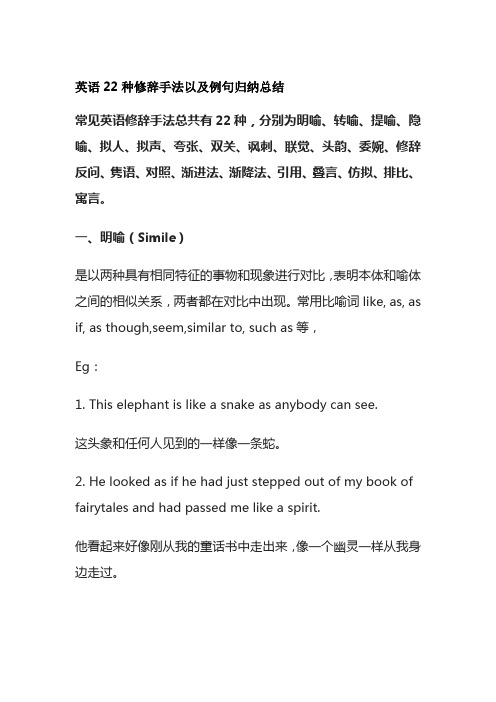
英语22种修辞手法以及例句归纳总结常见英语修辞手法总共有22种,分别为明喻、转喻、提喻、隐喻、拟人、拟声、夸张、双关、讽刺、联觉、头韵、委婉、修辞反问、隽语、对照、渐进法、渐降法、引用、叠言、仿拟、排比、寓言。
一、明喻(Simile)是以两种具有相同特征的事物和现象进行对比,表明本体和喻体之间的相似关系,两者都在对比中出现。
常用比喻词like, as, as if, as though,seem,similar to, such as等,Eg:1. This elephant is like a snake as anybody can see.这头象和任何人见到的一样像一条蛇。
2. He looked as if he had just stepped out of my book of fairytales and had passed me like a spirit.他看起来好像刚从我的童话书中走出来,像一个幽灵一样从我身边走过。
3. It has long leaves that sway in the wind like slim fingers reaching to touch something.它那长长的叶子在风中摆动,好像伸出纤细的手指去触摸什么东西似的。
二、隐喻(Metaphor)这种比喻不通过比喻词进行,而是直接将用事物当作乙事物来描写,甲乙两事物之间的联系和相似之处是暗含的。
Eg:1、The diamond department was the heart and center of the store.钻石部是商店的心脏和核心。
2. He is a pig.他简直是头猪。
(比喻:他是一个像猪一般的人,指肮脏,贪吃的人。
)3. She is a woman with a stony heart.她是一个铁石心肠的女人。
(比喻:这个女人冷酷无情。
)4.Mark Twain is a mirror of America.马克•吐温是美国的一面镜子。
英语19种修辞手法的全部解释和例句
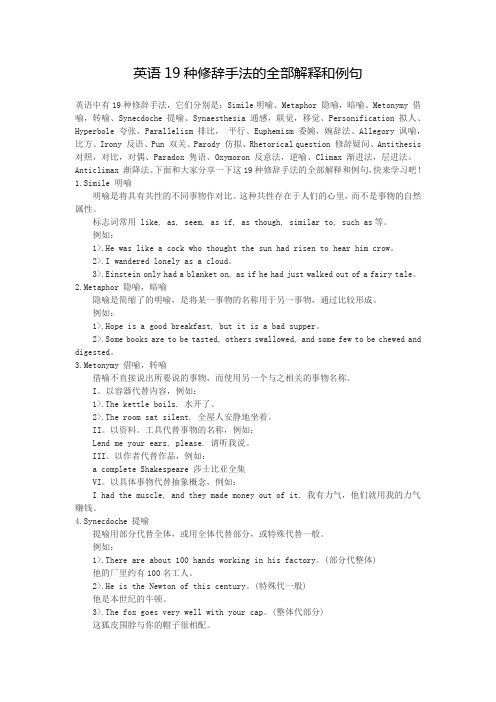
英语19种修辞手法的全部解释和例句英语中有19种修辞手法,它们分别是:Simile明喻、Metaphor 隐喻,暗喻、Metonymy 借喻,转喻、Synecdoche 提喻、Synaesthesia 通感,联觉,移觉、Personification 拟人、Hyperbole 夸张、Parallelism 排比,平行、Euphemism 委婉,婉辞法、Allegory 讽喻,比方、Irony 反语、Pun 双关、Parody 仿拟、Rhetorical question 修辞疑问、Antithesis 对照,对比,对偶、Paradox 隽语、Oxymoron 反意法,逆喻、Climax 渐进法,层进法、Anticlimax 渐降法。
下面和大家分享一下这19种修辞手法的全部解释和例句,快来学习吧!1.Simile 明喻明喻是将具有共性的不同事物作对比。
这种共性存在于人们的心里,而不是事物的自然属性。
标志词常用 like, as, seem, as if, as though, similar to, such as等。
例如:1>.He was like a cock who thought the sun had risen to hear him crow。
2>.I wandered lonely as a cloud。
3>.Einstein only had a blanket on, as if he had just walked out of a fairy tale。
2.Metaphor 隐喻,暗喻隐喻是简缩了的明喻,是将某一事物的名称用于另一事物,通过比较形成。
例如:1>.Hope is a good breakfast, but it is a bad supper。
2>.Some books are to be tasted, others swallowed, and some few to be chewed and digested。
英语13种修辞手法
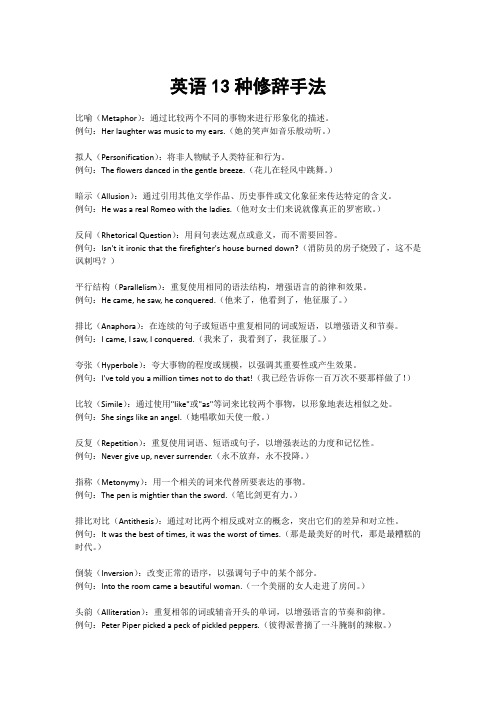
英语13种修辞手法比喻(Metaphor):通过比较两个不同的事物来进行形象化的描述。
例句:Her laughter was music to my ears.(她的笑声如音乐般动听。
)拟人(Personification):将非人物赋予人类特征和行为。
例句:The flowers danced in the gentle breeze.(花儿在轻风中跳舞。
)暗示(Allusion):通过引用其他文学作品、历史事件或文化象征来传达特定的含义。
例句:He was a real Romeo with the ladies.(他对女士们来说就像真正的罗密欧。
)反问(Rhetorical Question):用问句表达观点或意义,而不需要回答。
例句:Isn't it ironic that the firefighter's house burned down?(消防员的房子烧毁了,这不是讽刺吗?)平行结构(Parallelism):重复使用相同的语法结构,增强语言的韵律和效果。
例句:He came, he saw, he conquered.(他来了,他看到了,他征服了。
)排比(Anaphora):在连续的句子或短语中重复相同的词或短语,以增强语义和节奏。
例句:I came, I saw, I conquered.(我来了,我看到了,我征服了。
)夸张(Hyperbole):夸大事物的程度或规模,以强调其重要性或产生效果。
例句:I've told you a million times not to do that!(我已经告诉你一百万次不要那样做了!)比较(Simile):通过使用"like"或"as"等词来比较两个事物,以形象地表达相似之处。
例句:She sings like an angel.(她唱歌如天使一般。
)反复(Repetition):重复使用词语、短语或句子,以增强表达的力度和记忆性。
英语中的修辞手法
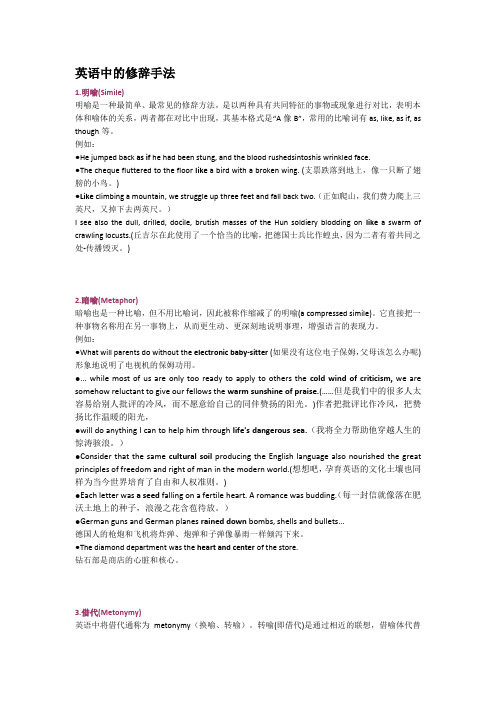
英语中的修辞手法1.明喻(Simile)明喻是一种最简单、最常见的修辞方法,是以两种具有共同特征的事物或现象进行对比,表明本体和喻体的关系,两者都在对比中出现,其基本格式是“A像B”,常用的比喻词有as, like, as if, as though等。
例如:●He jumped back as if he had been stung, and the blood rushedsintoshis wrinkled face.●The cheque fluttered to the floor like a bird with a broken wing. (支票跌落到地上,像一只断了翅膀的小鸟。
)●Like climbing a mountain, we struggle up three feet and fall back two.(正如爬山,我们费力爬上三英尺,又掉下去两英尺。
)I see also the dull, drilled, docile, brutish masses of the Hun soldiery blodding on like a swarm of crawling locusts.(丘吉尔在此使用了一个恰当的比喻,把德国士兵比作蝗虫,因为二者有着共同之处-传播毁灭。
)2.暗喻(Metaphor)暗喻也是一种比喻,但不用比喻词,因此被称作缩减了的明喻(a compressed simile)。
它直接把一种事物名称用在另一事物上,从而更生动、更深刻地说明事理,增强语言的表现力。
例如:●What will parents do without the electronic baby-sitter (如果没有这位电子保姆,父母该怎么办呢)形象地说明了电视机的保姆功用。
●... while most of us are only too ready to apply to others the cold wind of criticism, we are somehow reluctant to give our fellows the warm sunshine of praise.(……但是我们中的很多人太容易给别人批评的冷风,而不愿意给自己的同伴赞扬的阳光。
英文中最常见的20种修辞手法

•
• 2."Of course, you only carry large notes, no small change on you. " The waiter said to the beggar.
• 作者对乞丐说,当然,你只收大钞,所以没零钱啦。
• 12、pun 双关 • 双关就是用一个词在句子中的双重含义、借题发挥、作
the woods. • 我很开心,似乎听到了林中唱歌的鸟儿。
• 7、hyperbole 夸张 • 夸张是以言过其实的说法表达强调的目的。它可以加强语
势,增加表达效果。
• • 举个例子
• 1. I beg a thousand pardons. • 我千百次地祈求宽恕
• 2. Love you. You are the whole world to me, and the moon and the stars.
《My heart leaps up我心雀跃》)
• 17、oxymoron 反意法、逆喻 • • 这也是一种矛盾修辞法,用两种不相调和的特征形容一
个事物,以不协调的搭配使读者领悟句中微妙的含义。 • 往往这样的句子写出来具有很震撼的效果。 • • 例如: • 1. No light, but rather darkness visible. • 没有光,但有看得见的黑暗。 •
•
• 2. If we don't hang together, we shall hang separately.
• 如果我们不团结,就上吊去吧。(注意两个hang意思不 一样)
• 13、parody 仿拟 • 这是一种模仿名言、警句、谚语,改动其中部分词语从
英语的修辞手法

英语的修辞手法英语的修辞手法有很多种,其中一些常见的修辞手法包括:1. 比喻(Metaphor): 指的是用一个事物来比喻另一个事物,从而使语言更加生动、形象。
例如,"She is a lioness in the office." (她是一只办公室中的母狮子。
)2. 拟人(Personification): 指的是将事物或概念拟人化,从而使语言更加生动、形象。
例如,"The mountains were dressed in white and the sky wept tears." (群山披上白色,天空流下泪水。
)3. 排比(Parallelism): 指的是用相似的结构来表达三个或以上的事物,从而使语言更加有力、优美。
例如,"To fish, to hunt, to plant, to harvest, to eat." (钓鱼,打猎,种植,收获,食用。
)4. 夸张(Hyperbole): 指的是用夸张的手法来表达一个事物或概念,从而使语言更加生动、形象。
例如,"She is as fast as lightning." (她快如闪电。
)5. 反问(Rhetorical Question): 指的是用问题的形式来表达一个观点或情感,从而增强语言的力量。
例如,"Isn't life beautiful, floating on the waves of life?" (生活难道不美好吗?在生命的波浪上漂浮。
)6. 讽刺(Satire): 指的是用讽刺的手法来表达对某人或某事的不满或轻蔑,从而引起读者的共鸣。
例如,"The CEO is such a genius that he can even solve the problems of his own company." (CEO如此天才,甚至能解决自己公司的问题。
英语修辞手法
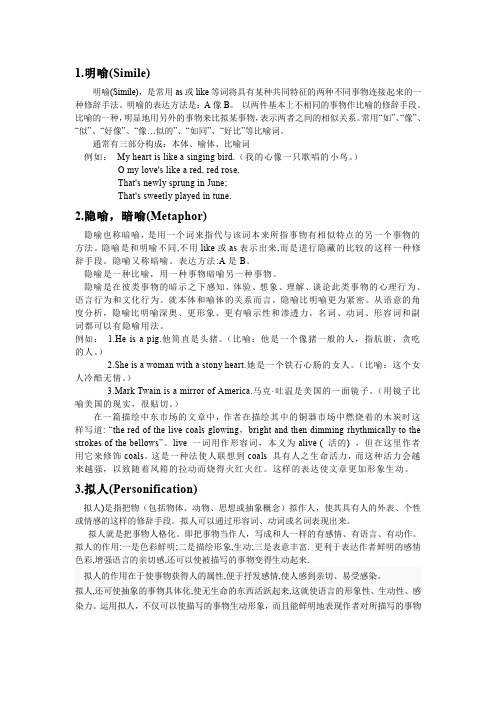
1.明喻(Simile)明喻(Simile),是常用as或like等词将具有某种共同特征的两种不同事物连接起来的一种修辞手法。
明喻的表达方法是:A像B。
以两件基本上不相同的事物作比喻的修辞手段。
比喻的一种,明显地用另外的事物来比拟某事物,表示两者之间的相似关系。
常用“如”、“像”、“似”、“好像”、“像…似的”、“如同”、“好比”等比喻词。
通常有三部分构成:本体、喻体、比喻词例如:My heart is like a singing bird.(我的心像一只歌唱的小鸟。
)O my love's like a red, red rose,That's newly sprung in June;That's sweetly played in tune.2.隐喻,暗喻(Metaphor)隐喻也称暗喻,是用一个词来指代与该词本来所指事物有相似特点的另一个事物的方法。
隐喻是和明喻不同,不用like或as表示出来,而是进行隐藏的比较的这样一种修辞手段。
隐喻又称暗喻。
表达方法:A是B。
隐喻是一种比喻,用一种事物暗喻另一种事物。
隐喻是在彼类事物的暗示之下感知、体验、想象、理解、谈论此类事物的心理行为、语言行为和文化行为。
就本体和喻体的关系而言,隐喻比明喻更为紧密。
从语意的角度分析,隐喻比明喻深奥、更形象、更有喻示性和渗透力。
名词、动词、形容词和副词都可以有隐喻用法。
例如: 1.He is a pig.他简直是头猪。
(比喻:他是一个像猪一般的人,指肮脏,贪吃的人。
)2.She is a woman with a stony heart.她是一个铁石心肠的女人。
(比喻:这个女人冷酷无情。
)3.Mark Twain is a mirror of America.马克·吐温是美国的一面镜子。
(用镜子比喻美国的现实,很贴切。
)在一篇描绘中东市场的文章中,作者在描绘其中的铜器市场中燃烧着的木炭时这样写道: “the red of the live coals glowing,bright and then dimming rhythmically to the strokes of the bellows”。
20种常见英文修辞手法
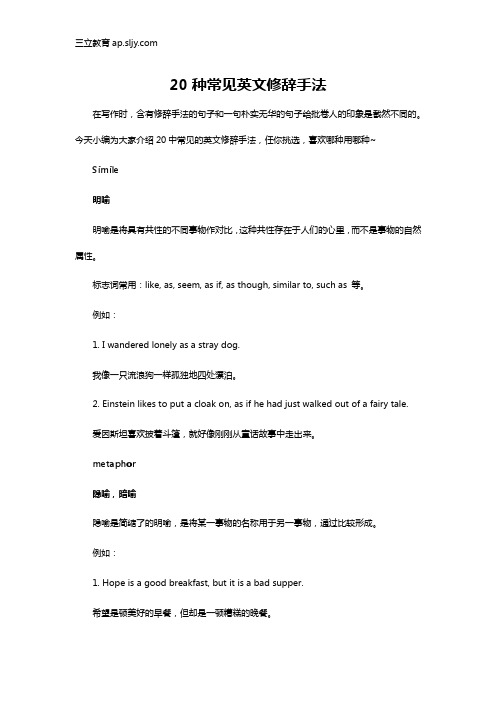
20种常见英文修辞手法在写作时,含有修辞手法的句子和一句朴实无华的句子给批卷人的印象是截然不同的。
今天小编为大家介绍20中常见的英文修辞手法,任你挑选,喜欢哪种用哪种~ Simile明喻明喻是将具有共性的不同事物作对比,这种共性存在于人们的心里,而不是事物的自然属性。
标志词常用:like, as, seem, as if, as though, similar to, such as 等。
例如:1. I wandered lonely as a stray dog.我像一只流浪狗一样孤独地四处漂泊。
2. Einstein likes to put a cloak on, as if he had just walked out of a fairy tale.爱因斯坦喜欢披着斗篷,就好像刚刚从童话故事中走出来。
metaphor隐喻,暗喻隐喻是简缩了的明喻,是将某一事物的名称用于另一事物,通过比较形成。
例如:1. Hope is a good breakfast, but it is a bad supper.希望是顿美好的早餐,但却是一顿糟糕的晚餐。
2. Some books are to be tasted, others swallowed, and some few to be chewed and digested.一些书需要被“浅尝辄止”地阅读,另一些需要被“狼吞虎咽”般地阅读;很少一部分需要被“细嚼慢咽”地阅读。
metonymy借喻,转喻借喻不直接说出所要说的事物,而使用另一个与之相关的事物名称。
1. 以容器代替内容,例如:1)The kettle boils.水开了。
2)The room sat silent.全屋人安静地坐着。
2. 以资料、工具代替事物的名称,例如:Lend me your ears, please.请听我说。
3. 以作者代替作品,例如:a complete Shakespeare莎士比亚全集4. 以具体事物代替抽象概念,例如:I had the muscle, and they made money out of it.我有力气,他们就用我的力气赚钱。
英语中所有19种修辞手法的
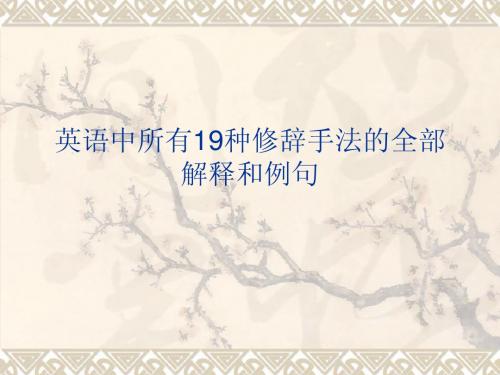
16.Paradox 隽语
隽语 这是一种貌似矛盾,但包含一定哲理的意味深 长的说法,是一种矛盾修辞法.. 例如: 1>.More haste, less speed.欲速则不达 2>.The child is the father to the man.(童年 时代可决定人之未来)三岁看大,四岁看老。
14.Rhetorical question 修辞疑问(反 问)
它与疑问句的不同在于它并不以得到答复为目的,而是以疑问 为手段,取得修辞上的效果,其特点是:肯定问句表示强烈否定, 而否定问句表示强烈的肯定.它的答案往往是不言而喻的. 例如: 1>.How was it possible to walk for an hour through the woods and see nothing worth of note? 2>.Shall we allow those untruths to go unanswered? 3>.If you give a girl an inch nowadays she will make address of it.
13.Parody 仿拟
这是一种模仿名言.警句.谚语,改动其中部分
词语,从而使其产生新意的修辞. 例如: 1>.Rome was not built in a day, nor in a year. 2>.A friend in need is a friend to be avoided.
11.Irony 反语
反语指用相反意义的词来表达意思的作文方式.如在 指责过失.错误时,用赞同过失的说法,而在表扬时,则 近乎责难的说法. 例如: 1>.It would be a fine thing indeed not knowing what time it was in the morning. 早上没有时间观念还真是一件好事啊(真实含义是 应该明确早上的时间观念) 2>"Of course, you only carry large notes, no small change on you. "the waiter said to the beggar.
英语30种修辞手法
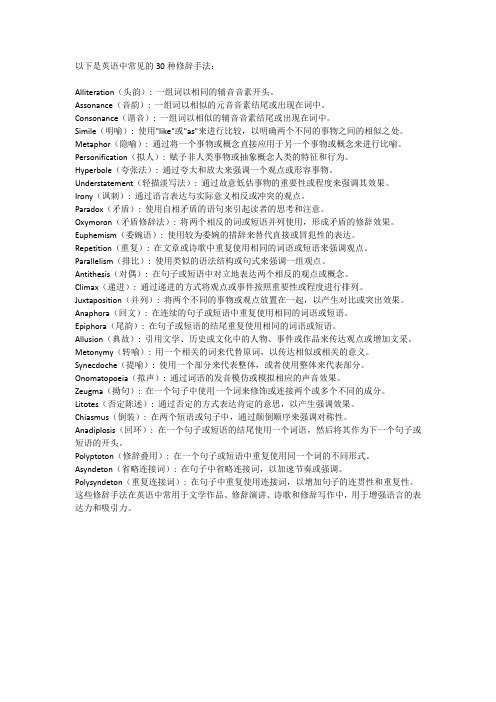
以下是英语中常见的30种修辞手法:Alliteration(头韵): 一组词以相同的辅音音素开头。
Assonance(音韵): 一组词以相似的元音音素结尾或出现在词中。
Consonance(谐音): 一组词以相似的辅音音素结尾或出现在词中。
Simile(明喻): 使用"like"或"as"来进行比较,以明确两个不同的事物之间的相似之处。
Metaphor(隐喻): 通过将一个事物或概念直接应用于另一个事物或概念来进行比喻。
Personification(拟人): 赋予非人类事物或抽象概念人类的特征和行为。
Hyperbole(夸张法): 通过夸大和放大来强调一个观点或形容事物。
Understatement(轻描淡写法): 通过故意低估事物的重要性或程度来强调其效果。
Irony(讽刺): 通过语言表达与实际意义相反或冲突的观点。
Paradox(矛盾): 使用自相矛盾的语句来引起读者的思考和注意。
Oxymoron(矛盾修辞法): 将两个相反的词或短语并列使用,形成矛盾的修辞效果。
Euphemism(委婉语): 使用较为委婉的措辞来替代直接或冒犯性的表达。
Repetition(重复): 在文章或诗歌中重复使用相同的词语或短语来强调观点。
Parallelism(排比): 使用类似的语法结构或句式来强调一组观点。
Antithesis(对偶): 在句子或短语中对立地表达两个相反的观点或概念。
Climax(递进): 通过递进的方式将观点或事件按照重要性或程度进行排列。
Juxtaposition(并列): 将两个不同的事物或观点放置在一起,以产生对比或突出效果。
Anaphora(回文): 在连续的句子或短语中重复使用相同的词语或短语。
Epiphora(尾韵): 在句子或短语的结尾重复使用相同的词语或短语。
Allusion(典故): 引用文学、历史或文化中的人物、事件或作品来传达观点或增加文采。
- 1、下载文档前请自行甄别文档内容的完整性,平台不提供额外的编辑、内容补充、找答案等附加服务。
- 2、"仅部分预览"的文档,不可在线预览部分如存在完整性等问题,可反馈申请退款(可完整预览的文档不适用该条件!)。
- 3、如文档侵犯您的权益,请联系客服反馈,我们会尽快为您处理(人工客服工作时间:9:00-18:30)。
英语修辞1.音韵修辞格(phonetic devices)(1).头韵(Alliteration)在英语语言中两个或两个以上的相邻单词以相同的首音因素开头,形成顺口悦耳的读音,称为头韵修辞手法。
Eg : A light heart lives long.Will, work and wait are the pyramidal cornerstones for success.(2) 元韵(Assonance)若干押音单词重读音节中辅音虽不同而元音相同。
Eg : The first wealth is health .(3).谐音(Assonance)Eg: litter and batter.Dress and boss.(4). 拟声(onomatopoeia)指通过仿拟相关事物的声音来构词。
Eg : A window rattles. Giggle meow2.语义修辞格(semantic devices)。
(1) 讽喻(allegory).以其他的事物形象来叙述事物,通常叙述的事是一个故事,故事中的人物,事件及发生的事情别具意义,如寓言等。
Eg : A farmer was driving his cart along a country road.The cart got stuck in the mud, but the farmer made no effort to get it out. Instead he began to pray to the gods for help. The God finally appeared and told the man to get busy and push it. “Put your shoulder to the wheel ,”God advised. The moral of this story is clear: we must not rely on others for help. Another saying which has come from this fable is, “God help those who help themselves.(2)隐喻(Allusion)指间接的提及某物,顺便提到。
Eg : It’s no use crying over spilt milk, because all the forces of the universe were bent on spilling it .(3)类比(analogy)同类相比,属于一种推理方式,由此及彼。
Eg : appropriate praise to a child is what the sun to a flower.(4)警句(epigram)用简洁的语句说明复杂的事物,揭示深刻的哲理。
Eg : It is easy to buy books than to read them, and easier to read them than to absorb them.(5)委婉语(euphemism)表示用温和的,简洁的或模棱两可的表达方式来替换那些被人们认为是令人讨厌的,粗野的或直言不讳的词语。
Eg: to be in Heaven to feel one’s age to lay off(6)夸张(hyperbole)指运用想象,通过对描述对象在数量,形象,特征,作用等方面的夸大或缩小,突出事物的某种特征或品质,鲜明的表达思想情感,从而达到强调的目的。
Eg: I am greater than the stars for I know that they are up in the sky and they don’t know that I am down on the earth.(7).反语(irony)表示幽默诙谐,谴责讽刺,批评蔑视等意义。
Egg:Slowly the old lady stopped to pick (the cheque ) up.Her present , her lovely present, with trembling fingers she tore it into little bits.(8).暗语(Metaphor)用表示别的事物的词语来描述心中的事物。
The world is a stage.Time is a dressmaker specializing in a alteration.(9).借喻(metonymy)亦称为转喻,通过对两者相近或类似的特征的联想,借喻体来代替本体。
Eg : table :source ,supply of food.She sets a good table.Pen: what is written by pen, books, articles, etc.He earns his living by his pen.(10)矛盾(oxymoron)用意义相抵触的,甚至相反的词语并列,通过其矛盾碰撞来产生修辞效果。
Eg : a small fortune same differentSilent scream sweet sorrow(11)隽语(paradox)用貌似大缪不然,实含智慧的语句表达出警世之意,诲人之理,从中看出说话人的机智,聪慧和智谋。
Eg : Juliet : My only love sprung from my only hate;Too early seen unknown, and known too late!Prodigious birth of love it is to me,That I must love a loathed enemy.(12)拟人(personification)一种把人类性状或感情赋予动物,把生命及人类属性赋予无生命之物或抽象概念,或把人类的特点,特性加于外界事物上,使之人格化的修辞手法。
Eg : envy has no holiday.She sat like patience on a monument, smiling at grief.(13)双关语(pun)利用词或词组本身所具有的多重含义或不同用法言陈意许,兼指彼此来营造语言幽默的效果。
Egg : On Sunday they pray for you and on Monday they prey for you .他们星期日为你祈祷,星期一对你敲诈。
An ambassador is an honest man who lies abroad for the good of his country.大使是一个为了本国利益而在国外说谎的诚实的人。
(14)挖苦(ridicule)用貌似崇敬,但又略带荒缪的语句,或用平静,甚至平静到几乎冷酷的语句来叙述或评论对方,是对方显得滑稽可笑,卑鄙无耻,如坐针毡,如芒在背,求生无门,求死不能的境地。
Eg : The judge is condemned when the criminal is acquitted.宣判罪犯无罪,就等于宣判法官有罪。
Necessity has no law. “需要”面前无法律。
(15)讥讽(sarcasm)以直接的方式攻击,伤害对方的感情,故语言使用直截了当,措辞尖锐,刻薄,话语简短,明了。
字里行间充满着轻视,蔑视和敌视之意。
It is a human nature to hate the man whom you have hurt.(讽刺人性扭曲的现象)When we are born, we cry that we are coming to this great stage of fools. (感慨人世混浊,人生悲凉)(16)讽刺(satire)文字比较优雅,字斟句酌,比较正式,具有绅士风度。
Eg: The proud hate pride ----in others.骄傲的人也恨骄傲-----恨别人骄傲。
(17)明喻(simile)是以两种具有共同特征的事物或现象进行对比,表明喻体和本体的关系。
As busy as a bee as cold as iceShe eats like a bird. He drinks like a fish.(18) 提喻(synecdoche)指以局部喻指整体,或以整体喻指局部;以特殊喻指一般,或以一般喻指特殊;以抽象喻指具体,或以具体喻指抽象。
Eg : outside , (there is ) a sea of faces.外边街上一片人的海洋。
They shall the same roof.他们住在一起。
(19)移就格(Transferred Epithet)其修饰语形容词或起形容词作用的词组从本该由他们修饰的名词之前移开,而去修饰本不该由他们修饰的名词。
Eg: we had a lazy day yesterday.He often makes careless mistakes in his exams.(20)低调陈述(understatement)故意使用有节制的措辞来陈述事实,故意轻描淡写,借低调与弱化的语言形式来表示强调。
Eg : No one was more willing to do a favour for friendor neighbor than he.I know he is honest, and I wish I could add he werecapable.(21)轭式搭配(zeugma)两个主语或两个宾语同时与一个动词搭配,或是一个形容词同时修饰两个名词,其中只有一个是合适的,而另一个是搭上去的。
Eg: This hair style fits her and the times.3 句法修辞格(syntactic devices)(1)主动句和被动句(active and passive voiced sentenced)(2)倒装(Inversion)(3) 松散句和圆周句(loose sentence and periodicsentences)(4) 排比(parallelism)(5) 长短句(short and long sentence)。
